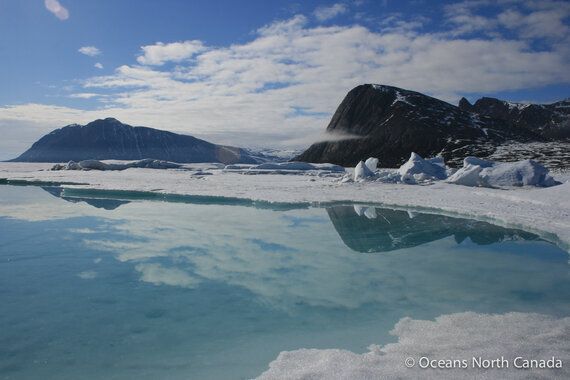
Lancaster Sound (Photo by Chris Debicki/Oceans North Canada)
In the 18 years I've worked at the Nature Conservancy of Canada (NCC), I've seen the wonderful things that can happen when people and private organizations work together to protect our most precious natural areas. Through land gifting arrangements such as conservation agreements -- where landowners agree to limit some uses of their property to protect natural features and resident species -- as well as cash and stock donations, we've conserved 2.8 million acres (more than 1.1 million hectares) of ecologically significant land across the country since 1962.
Lancaster Sound is a recent example of these successes. There is no question that this collaboration between Shell, NCC and the Government of Canada and local communities is a remarkable and significant step towards conservation.
It will also be an important contribution to Canada's commitment under the Convention on Biological Diversity -- a global commitment signed by close to 170 countries, which has set protection targets at 17 per cent for terrestrial and inland water, and 10 per cent for coastal and marine areas, by 2020. Yet today in Canada, only about 11 per cent of terrestrial areas and inland water and about one percent of marine regions are protected.
Once the National Marine Conservation Area at Lancaster Sound is completed, it is expected to measure close to 2.1 million acres. But the reality is that despite its size, this area, once conserved, will raise Canada's contribution to the global target for marine conservation by less than one percent.
When framed in this way, this changes the scope of the challenge before us. If Canada is to meet its commitments to the Convention on Biological Diversity, we need to scale up the way we think about protected areas and partnerships in order to increase our impact. We at NCC, like most conservationists, see those targets as waypoints, not destinations.

Lancaster Sound (Photo by Parks Canada)
There is no question that NCC, in its more than 50 years, has accomplished much through its collaborative approach to conservation. As a national organization, NCC's work contributes to Canada's domestic and international goals for conservation. Yet imagine what we could do if we harnessed the collective energies and innovation of the technology, energy, communication and banking sectors. We haven't even scratched the surface of satellite and drone applications for conservation. We have enormous potential to match green infrastructure and grey infrastructure at the municipal level for cost-effective outcomes. Social Impact Bonds could be a tool to help accelerate large-scale conservation in Canada.
Governments play a critical role in helping to ensure Canada does its part in meeting the global community's commitments to terrestrial and marine protection -- such as through the Natural Areas Conservation Program, a public-private partnership to protect important natural habitat in southern Canada. But this task does not -- and should not -- rest entirely on the shoulders of the country's politicians and lawmakers; individuals and corporations can also make a world of difference.
Now is the time for us to take the big step. Conservation is no longer about creating one on one partnerships. Instead, we need to work together to advance the social bottom line, and make a significant difference towards our domestic and global contributions.
We need more success stories like Lancaster Sound to bring Canada's performance on land and water protection in line with the goals set out by the global community. By working together, we might just achieve these goals by 2020.
This post was written by Lisa McLaughlin, acting vice-president, conservation at the Nature Conservancy of Canada and originally appeared in the Globe and Mail.
Follow HuffPost Canada Blogs on Facebook